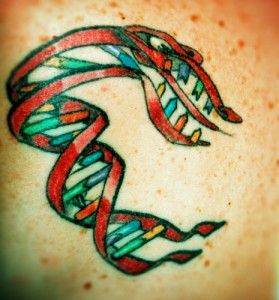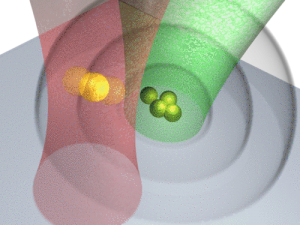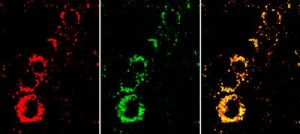I’m back with another New York Academy of Sciences public event (my Jan. 3, 2012 posting listed a number of events), this time it’s Science Ink: Tattoos of the Science Obsessed with Carl Zimmer. Here’s a description of the event (which will take place on Tuesday, Jan. 24, 2012 from 7 – 8:30 pm),
How much do you love science? Enough to get it permanently inked on your skin?
Join award-winning science journalist and New York Academy of Sciences regular Carl Zimmer for a talk on his latest book, Science Ink, which showcases over 300 tattoos dedicated to the pursuit of science.
Tattoos have been a part of human culture as far back as Neolithic times. Scientists have uncovered tattoos on mummified ancients from Western China to Egypt to Scandanavia. And the subjects of those tattoos vary as much as the cultures—from elaborate animal and organic designs to simple graphic designs thought to have therapeutic qualities. In more modern times in the Western world, tattoos came into vogue in the late 1800s when British elites began to tattoo themselves—both Winston Churchill and his mother, Lady Randolph Churchill, had tattoos. And today, it’s clear that in American culture, tattoos have had a resurgence in popularity.
Choosing what to mark your body with permanently is a source of much conversation and consternation. And as Carl Zimmer discovered after a blog post asking about science tattoos, there is a passionate group of people who made the choice to ink themselves with science.
In this special event, Zimmer will speak about the science and history of tattooing, and offer highlights from his book Science Ink, which features a gallery of scientific tattoos, spanning fields from evolutionary biology and neuroscience to mathematics and astrophysics. In addition, Zimmer is inviting a handful of those featured in the book to come and share the compelling personal stories behind their ink.
Here are more details about the event, pricing is as follows,
Member: $15
Student / Postdoc / Fellow Member: $10
Nonmember: $25
Student / Postdoc / Fellow Nonmember: $20
In a Jan. 9, 2012 posting on his blog, The Loom, Carl Zimmer offers more information about his book and upcoming talk plus a discount,
Get $10 dollars off admission by using the promo code ZIMMER. Register [here or http://www.nyas.org/scienceink]
The address and contact details:
The New York Academy of Sciences
7 World Trade Center
250 Greenwich Street, 40th floor
New York, NY 10007-2157
212.298.8600
nyas@nyas.org
As for Carl Zimmer and science tattoos, I decided to investigate a bit further. Here’s an excerpt from Carl Zimmer’s website bio webpage,
The New York Times Book Review calls Carl Zimmer “as fine a science essayist as we have.” In his books, essays, articles, and blog posts, Zimmer reports from the frontiers of biology, where scientists are expanding our understanding of life. He is a popular speaker at universities, medical schools, museums, and festivals, and he is also a frequent guest on radio programs such as Radio Lab and This American Life.
…
In addition to writing books, Zimmer has written hundreds of articles for the New York Times and magazines including National Geographic, Time, Scientific American, Science, and Popular Science. From 1994 to 1998 Zimmer was a senior editor at Discover, where he remains a contributing editor and writes a monthly column about the brain.
Since 2003, Zimmer has written the award-winning blog, The Loom. Along with essays about science, The Loom is also home to a popular gallery of science tattoos. In November 2011, Zimmer will publish a book of his favorite selections, called Science Ink: Tales of the Science Obsessed.
Zimmer is a lecturer at Yale University, where he teaches writing about science and the environment. He was also the first Visiting Scholar at the Science, Health, and Environment Reporting Program at New York University’s Arthur L. Carter Journalism Institute.
…
He is, to his knowledge, the only writer after whom a species of tapeworm has been named. [emphasis mine]
I do love a sense of humour. As for Zimmer’s latest book, Science Ink, his website offers some excerpts from it (here are a few samples),
Astrarium, p.71
“Although I’m not a scientist by trade,” writes Lauren Caldwell, “my work on seventeenth- and eighteenth-century British literature has provided ample opportunity for me to become acquainted with the work of some brilliant scientific innovators. Though we have discarded some of their ideas, their work retains all of its vital visual force. ¶ “Years ago I discovered and fell in love with the comprehensive diagrams in Giovanni de’Dondi’s 1364 Il Tractatus Astarii, which contained the plans for the first famous astrarium. Each piece has its own delicate mechanical beauty, but I chose for my backpiece the Mercury wheelwork. Of course, you couldn’t track Mercury with it—de’Dondi followed Ptolemy—but his astrarium remains a lovely and impressive testament to human ingenuity and curiosity. ¶ “The more spare geometrical diagrams that surround the de’Dondi piece are taken from Sir Isaac Newton’s Principia Mathematica—of which little enough, I imagine, need be said. Though in many respects these two men couldn’t have been more different, they shared a vision of a universe as elegant and aesthetically compelling today as it was when they lived and worked.”

Astrarium tattoo (from Science Ink by Carl Zimmer)
DNA monster, bottom p.102
Jay Phelan, a biologist at UCLA, got his DNA tattoo in 1990 while he was in graduate school. “As I got deeper into the study of evolution, genetics, and human behavior,” he writes, “I realized that there was a tension between what my genes ‘wanted’ me to do and what I wanted to do, from the fattiness of the foods I ate, to the selfishness/selflessness I showed to others, to issues with managing my money, my risk-taking, and my relationships, and more. It dawned on me that I was fighting a never-ending battle. Anyway, I tried to come up with a design that captured that tension and, once I did, decided to get it tattooed on my back.”

DNA monster tattoo (from Science Ink by Carl Zimmer)
I was sufficiently fascinated to send off a few questions to Carl Zimmer about science tattoos and his upcoming talk at the NYAS and he very kindly replied,
- Given the title of your latest book (Science Ink: Tattoos of the Science Obsessed), I’m wondering if you have any tattoos.
If so, what is it?
I don’t have any tattoos actually. I’ve never been particularly interested in getting one, and am no big fan of needles. But I find the lack of a tattoo is no impediment to appreciating the tattoos of scientists. If I sell of whole bunch of copies of the book, maybe I’ll have to celebrate by getting one. I was thinking about getting my wife’s name, Grace, spelled out as amino acids.
- What most surprised you about this book?
At first the surprise was simply that any scientist at all had tattoos. The initial flood of pictures that filled up my e-mail inbox was amazing. After I got accustomed to the idea that there is lots and lots of scientists with tattoos out there, the next big surprise was how many interesting stories there were, illustrated by these tattoos. Stories from the history of science, stories from the personal lives of the scientists. And since telling stories is my job, I decided to turn Science Ink into a book of miniature essays.
- Is there any branch of science that attracts more people who are willing to ink their bodies?
I don’t see any field being way in the lead compared other ones. In fact, what really impressed me was that just about every branch of science I can imagine ended up being represented in the book. I have groups of linguistics tattoos in the book, astronomy tattoo,s medical tattoos ,tattoos about quantum physics, and so on. Basically, by looking at these tattoos you end up taking a tour of all science.
- Could you briefly preview a little bit of your Ja.24.12 talk?
I’m going to be talking at the New York Academy of Sciences about what got me into this peculiar project, and some of the things I learned about scientists and science in the process. But I’m also going to be talking about tattooing itself. It’s actually a pretty fascinating scientific subject in its own right. Anthropologists have found evidence of tattooing in many cultures around the world, and it goes back thousands of years. So I think that tattoos speak to something really important about what it means to be human–and, in this particular case, what it means to be a scientist.
Dear Carl, Thank you for taking time out of a very busy schedule (he has a talk scheduled Jan. 20, 2012 too; scroll down to the next paragraph for information about that event plus all of his usual work) to respond. I hope the book is a huge success.
There is one other related Science Ink event that might be of interest. The ScienceOnline2012 conference, January 19 – 21, 2012 (no spaces left for attendees), held annually in Durham, North Carolina and (mentioned in my Nov. 2, 2011 posting) is hosting a Science of Ink tour for 30 people to the Dogstar Tattoo Company on Friday, Jan. 20, 2012. The webpage for the tour notes that it is completely booked but if you follow the Twitter hash tag (#SciInk) you may be able to get on the tour (as people do drop out of these things for one reason or another). From the tour webpage,
Join us on Friday afternoon, January 20th, at the Dogstar Tattoo Company in Durham, NC’s Golden Belt district for a lecture by Carl Zimmer on the science of tattoos, a reception & tour of the studio, and the opportunity to get inked (or just watch the process!). Carl will have his book, Science Ink: The Tattoos of the Science Obsessed available–and we can probably convince him to sign a few ☺
This isn’t your typical tattoo shop. When Carl Zimmer first saw the photos, he declared, “It’s like a cathedral of tattoo parlors.”
…
When you register, please indicate if you definitely plan to get a tattoo, might want to get a tattoo, or definitely don’t plan to get inked (but want to observe). [emphasis mine]
Good luck with getting on the tour or getting to the talk in New York. As for anyone from Vancouver who might be hoping that Carl Zimmer will be here for the American Association for the Advancement of Science (AAAS) 2012 annual meeting, sadly, the answer is no.



